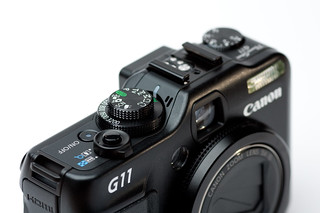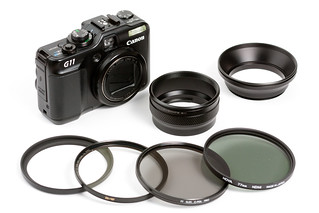Canon PowerShot G11

|
| Canon G11 + Lensmate image by Victor van Dijk (Image rights) |
The PowerShot G11 represented an interesting crossroads for Canon, their 2009 rethinking of what the enthusiast customers for their successful G series might want in a "serious compact."
Where marketing would seem to demand that megapixel counts forever march higher (and the PowerShot G10 already boasted a surprising 14 Mp), the G11 took the unprecedented step of reducing the pixel count to 10 megapixels. This reflected increasing photographer wariness that ever-tinier pixels come at the cost of worsened high-ISO performance,[1] and perhaps the growing pervasiveness of low-resolution screens as the modern world's dominant context for viewing photographs. In any case, Canon claimed a two-stop advantage in high-ISO performance over the G10, and independent tests did show noticeable improvement.[2] Ultimately, the decision to hold the line at 10 megapixels became the standard for nearly all 2010-2011 "enthusiast" compacts, such as Canon's own PowerShot S90, the Ricoh GR Digital III, Panasonic's LX5, and Canon's followup PowerShot G12.
In the G11, Canon also reinstated a much appreciated tilt-swivel rear LCD screen, last seen in the PowerShot G6. Retained from the G10 was a stout, well-finished body with traditionalist knurled control knobs, and the ability to record images in RAW mode. The 5x zoom covered a range from 28-140mm (in 35mm film-equivalent terms), opening to f/2.8 at the wide-angle end and f/4.5 at the telephoto one.

|
| Traditionalist control dials image by Victor van Dijk (Image rights) |

|
| With accessory barrels for adapting filters image by Victor van Dijk (Image rights) |
Notes
- ↑ This point is controversial. Smaller pixels do imply greater pixel-to-pixel variation in brightness; i.e. noise. Suppressing this may require noise-reduction processing, which itself may result in unpleasant, smeary artifacts. However, when an image is viewed at moderate dimensions, little of this is apparent (although then, neither is any higher sensor resolution). Yet photographers seem unable to resist looking at their images onscreen at 100% magnification, where these effects are apparent; and in any case Canon was responding to a popular perception among enthusiast photographers, if not an engineer's viewpoint.
- ↑ DPReview "Studio scene comparison (higher sensitivity JPEGs)" page from the full review